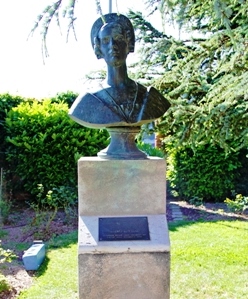The Russian Riviera

If you visit the port at Villefranche-sur-Mer you will be greeted, on a curve of the road, by three small bronze busts on white plinths. These consist of two admirals and one maritime general. These gentlemen commanded ships of the Russian Royal fleet in the 18th century during the first accord with the Kingdom of Sardinia which gave permission for the fleet to use Villefranche as a port of call during the Russian-Turkish war.
Left – Bust Tsarina Alexandra Feodorovna (Charlotte of Prussia)
Forward around 80 years and a fresh agreement was made between Russia and the Kingdom of Sardinia to establish a more permanent Russian naval base at Villefranche, equipped to service the ships of the fleet, along with workshops, a forge and a clinic. But the gentlemen on their plinths are not alone for, not too far away on the port, is the bust of a Russian Empress who lived around 100 years later. The Tsarina Alexandra Feodorovna (Charlotte of Prussia) was the wife of Tsar Nicholas 1st of Russia and mother of his seven children. With the death of her husband in 1855 she became the Dowager Empress and her son, Alexander II, the new Tsar. In 1856 Alexandra came to Villefranche by ship and, with her grand entourage, travelled onwards to Nice. Here she would stay twice for the winter season, in 1856-1857 and 1859-1860, becoming much involved with the town. When Nice and its region was ceded back to France in 1860 Alexandra’s diplomacy had already smoothed the way for Napoleon III to agree to allow the Russian maritime concession to continue, which it did until the end of the 1870s.
Alexandra and her son presided over a Russian court whose sumptuousness was established in the reign of Catherine the Great. It was said that St. Petersburg’s riches and luxury were ‘beyond belief’. The streets were filled with various mounted guards’ regiments in wonderful uniforms. The ladies of the Imperial Court, of which there were many, wore gowns of silk embroidered with gold and embellished with wonderful jewels. A visitor from France reported that at the grand balls one ‘could walk on pearls and sapphires’, presumably flung from the opulent ball gowns as the women danced.

Russia was a huge empire organised for wealth and loyalty. The wealth came from the imperial mines, quarries and the land. All these were worked by the peasants – the serfs – virtually slaves, who could be bought and sold by their masters. If these masters were of a kindly disposition the life of their serfs, although poor, was liveable. But in the towns, for the disposed, the conditions were appalling. Often living in damp and freezing basements, their feet wrapped in rags if they possessed no shoes, here the poor lived in dreadful poverty. This disparity would, of course, have consequences.
Right – Portrait of Tsarina Alexandra Feodorovna
Alexandra Feodorova, with her court, imperial family and aspirational hangers-on, laid the foundation of the Russian colony in Nice. She rented The Villa Bermond and the Villa Peillon for her stays where she gave concerts, entertained and became involved with the town. She helped to organise, and partially funded, the first small Russian Orthodox church in Nice, on the rue Longchamp. By 1859 the church was finished and there were 150 Russian families living in, or winter visiting, the town. And many had fascinating, and dramatic, lives.
© Copyright: Maureen Emerson 2019
